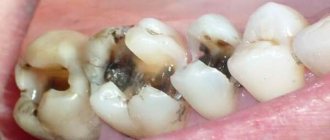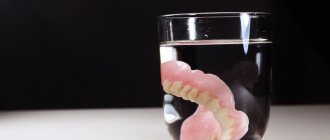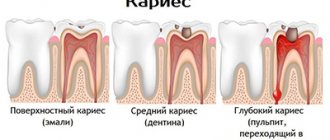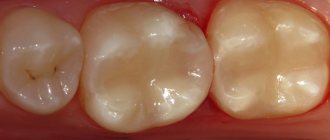- Features of installing a temporary filling
- Why can a temporary filling fall out?
- What to do when a filling falls out
- If the filling falls out on the day of installation
- Loss of filling in sealed and unsealed canals
Temporary fillings are made from composites. Its installation is necessary to seal and protect the tooth cavity during the treatment period. The main task is to prevent the penetration of pathological microorganisms and remnants of food consumed by the patient into the dental canals. Unlike composites, which are fixed after treatment is completed, such a filling can be removed to continue dental procedures. Insufficient fixation can lead to a piece of composite falling out on its own. In order not to provoke complications or damage to the internal cavity of the tooth, you need to know what to do if a temporary filling falls out.
Content:
- Why are temporary fillings placed?
- Why use it - indications for use
- How long can you walk with such protection?
- Manufacturing materials
- How does the installation work?
- Rules of care
- If the coating collapses prematurely
- How does the replacement work?
Often, patients at dental clinics are faced with a situation where the doctor gives them a cheap intermediate filling and indicates the day when they need to come back for a follow-up appointment to replace it with a permanent one. We suggest you understand this treatment tactics and its features.
Stages of treatment using arsenic
Installing paste containing arsenic is not a complicated procedure. It is performed under anesthesia if there is severe pain. In this case, it is necessary to pick out the pulp and remove dentin that cannot be restored. Then a ball of paste is placed in this place. A tampon soaked in a mixture of camphor plus phenol is placed on top of it to prevent infection. And finally, an airtight bandage made of a paste-like substance containing artificial dentin.
To prevent the medicinal paste from entering the oral cavity and gastrointestinal tract, the doctor places a temporary filling. After which the patient is given a period after which he needs to remove it in the clinic. Two days are usually enough to completely kill the nerve. The maximum period for which an arsenic composition can be left in the inside of a tooth is no more than one week. Since after this period the drug will have a bad effect on the dental structure, microflora and further functioning, doctors will quickly remove the old filling and remove the drug.
Why are temporary fillings placed?
They are intended for:
- protecting the damaged dental area from the destructive influence of pathogens;
- preventing the accumulation of food debris in the carious “hollow”;
- reliable fixation of the applied medicinal mixture.
Under the filling material there is always a special medicine that treats the unit from the inside, or a paste that kills the nerve. It turns out that a non-permanent filling is indicated in cases where multi-stage therapy is carried out.
What determines the service life of a filling?
As already mentioned, the average lifespan of a filling is about five years, but it is optimal to determine it individually, since it depends on a number of factors:
- Properties and characteristics of the filling material that was used;
- The dentist’s compliance with technological processes during installation;
- The condition of the unit being sealed (the degree of its destruction, the thickness of the walls);
- Hygienic measures of the oral cavity (regularity and correctness of their implementation, brushes and pastes used by the patient);
- Regular consumption of hard foods and sugar.
There are cases when, provided they are installed correctly and provided with good care, fillings can serve patients well for more than ten years.
Why use it - indications for use
Dentists install temporary filling compounds for:
- Advanced caries. If the cavity is very deep, after it has been cleansed of the affected tissue, a medicinal solution is applied to make the layer between the open area of the crown and the dentin as strong as possible.
- Progressive acute pulpitis. Requires depulpation. For this purpose, a medicine is placed into the “hole” that destroys the nerve. It is covered with a protective insulating compound, which will be replaced in the future.
- Periodontitis. With this disease, progressive inflammation in the root area is observed. To stop it, the dentist puts an antiseptic medicine inside the canals. To securely fix it, a hardening gel is placed on top.
- Complicated carious process. Sometimes dentists are faced with a non-standard course of a diagnosed disease. Then, in order to select an effective treatment, they decide to observe the dynamics. In this case, there is no point in installing a permanent element - it will most likely have to be removed soon. Therefore, preference is given to the temporary.
- Manufacturing of dental crowns and bridges. After impressions are taken, it is important to protect the sawn parts of the unit. To do this, use a temporary filling or crown.
Sometimes non-permanent filling is used during the sanitation of dental canals. This is necessary to prevent recurrence of the treated disease. The specialist thoroughly cleans all intradental areas, then applies an antiseptic and closes it on top for a certain period of time. During repeated appointments, he uses permanent hardening mixtures.
What to do if a tooth hurts after filling?
There is no need to endure pain symptoms under a filled tooth. At home, you can temporarily use regular pharmaceutical products. However, if this does not help, especially at night, you should immediately go to the doctor and take out the paste. Sometimes the pain increases to an unbearable degree. This is possible in the following cases:
- insufficient dosage or the presence of a high threshold of sensitivity to the drug in a person,
- the duration of the period of exposure of the substance to the nerve, when the pain subsides only by the third day,
- the drug inflames the soft tissue, which is accompanied by swelling, and the temperature may rise, you should urgently consult a doctor and get the paste,
- the occurrence of inflammation in any part of the tooth is a serious problem that requires lengthy and expensive treatment,
- if you are intolerant to one of the components of the paste or arsenic, when allergic swelling or other dangerous reactions occur, for example, a shock effect, if symptoms increase, immediately call an ambulance,
- incorrect installation of the drug.
How long can you walk with such protection?
Compliance with the terms of wearing is a guarantee that nothing will happen to the tooth. If time is missed, the medicine placed inside the unit will begin to destroy its walls. It will also become leaky, which means that pathogenic microorganisms will begin to actively multiply in the resulting microgaps.
The exact wearing period depends on the characteristics of the material used and the dental diagnosis. The doctor calls him. If we are talking about a paste that destroys nerve tissue, then it is removed after 5-10 days. It happens that you have to repeat the procedure several times, but there is nothing to worry about. If the composition is placed inside the unit to stimulate regeneration processes, then therapy takes about two to three weeks.
How to remove arsenic from a tooth yourself at home?
If you need to extract arsenic paste yourself at home, without visiting a doctor, then you should correctly follow these steps:
- cleanse tooth enamel,
- wash your hands with soap,
- disinfect any thin metal needle in an aqueous solution of alcohol or potassium permanganate,
- Use a needle to loosen the filling shallowly at the mirror and try to remove the medicine at one time,
- for speedy neutralization and healing, rinse the oral cavity with an aqueous solution of soda or chamomile infusion,
- place a tightly twisted cotton band into the exposed tooth,
- To avoid nerve decomposition and tooth destruction, visit a doctor on the same day.
Manufacturing materials
When choosing a composition for temporary closure of a carious cavity, the following are taken into account:
- size of the lesion;
- diagnosis;
- expected duration of treatment;
- the patient is allergic to medications.
Most often, doctors use the following intermediate-acting filling solutions:
- From kaolin and zinc sulfate. The mixture allows you to partially restore dentin - the hard crown part located under the enamel.
- Polycarboxylate. Low-toxic cement used to fix a crown, inlay or dental bridge. Can act as an insulating gasket when installing amalgam and cement elements.
- Karyosan. Zinc oxyeugenol cement, formed by zinc oxide and eugenol. Shows analgesic and antiseptic properties. Used to disinfect canals and relieve inflammation.
- Vinoxol. Includes zinc oxide and a solution of polystyrene in guaiacol. High-quality artificial dentin that can withstand chewing load for one to two months.
- Glass ionomer cement. Suitable if you need to fix dentures for a short period of time.
Is it always possible to replace an old filling with a new one?
Depending on the degree of tooth decay and aesthetic requirements, restoration can be done:
1. Filling made of composite material. As a rule, if the tooth decay is less than 50%
2. Veneer or componir in case of restoration of the anterior group of teeth - Veneer - the thinnest porcelain plate made in a dental laboratory using an individual impression - Componir - a budget analogue of a veneer, made in a factory from composite materials
3. Inlay made of composite material or ceramics. In case the tooth is destroyed by more than 50%. An inlay is a “large” filling that is made in a dental laboratory. It is much stronger than a filling and better conveys the anatomical features of the teeth and matches the color
4. A crown made of metal ceramics or zirconium dioxide. A crown is installed in case of significant tooth decay
If the crown part of a tooth is completely destroyed, then a crown will be the best solution to preserve it, since under heavy chewing load the wall of a tooth covered with a filling may break off, and if the crack goes under the gum, then the tooth will have to be parted with.
How does the installation work?
Since the composition is intermediate and is laid down for a specific purpose, it is logical that its use is preceded by certain preparatory manipulations:
- The doctor cleans the affected area using a drill and medical instruments. He carefully removes the remnants of altered tissue to prevent further destruction of the crown.
- Then it processes the channels. There are two options here - either the nerve is removed immediately, followed by washing the roots with an antiseptic, or a medicinal mixture is applied.
- A filling is placed on top, which will soon be replaced.
- Before letting the patient go, the dentist tells you how to care for the tooth , when to come next time, and what to do if the mixture falls out prematurely.
Symptoms to look out for if you have fillings in your mouth
Dentists identify a number of symptoms that indicate the need to seek professional help. Removal of the filling followed by tooth treatment may be required if the patient notes:
- Reactions of teeth to cold or hot food;
- Darkening of tooth enamel or filling;
- Bleeding gums during hygiene procedures;
- Their inflammation or change in color;
- Mobility of the filling or fragments breaking off from it.
Due to the fact that during a routine dental examination it is not possible to identify caries under a filling, the patient is prescribed a visiography. It will provide an image of the affected unit, which allows the development of caries to be determined.
Rules of care
A temporary “barrier” is less durable than a permanent one. He is able to cope with the chewing load for up to two to three weeks. If you "carry" it, it will collapse or fall out. In this regard, until the dentist replaces it with a permanent one, it is important to follow the following rules:
- Avoid eating too solid foods. Nuts, crackers, seeds, etc. are prohibited.
- Do not use chewing gum or sticky candies.
- Carry out hygienic cleaning twice a day - in the morning and in the evening after meals. Use only a brush with soft bristles.
- Do not use a paste containing abrasive particles during treatment.
- After each meal, hygienically rinse the mouth with warm water.
By keeping these rules in mind, you can significantly reduce the likelihood of destruction of the established composition.
How long can you keep arsenic in your tooth?
The most common practice is to apply arsenic paste to single-rooted teeth for one day. For other dental canals up to 48 hours.
The time of the scheduled examination prescribed by the doctor is mandatory for the patient. If the toothache has stopped, you should visit a dentist who can remove the toothpaste. To avoid unwanted complications, using paste with arsenic in the tooth for more than three days is unacceptable. It is necessary to find out what substance the doctor used. For example, the paste can remain in the tooth cavity for up to two days, but overexposure to arsenic can lead to blackening of the dentin.
If the coating collapses prematurely
It happens that one day a person notices that the carious cavity is left without protection. No need to panic. The fact that a diseased tooth is open to invasion by pathogenic microflora is bad, but it is easy to fix. You should immediately visit your dentist to have it refilled.
If for some reason it is impossible to do this, and the visit has to be postponed by several days, you should monitor the condition of the “hole” and ensure that food debris does not collect in it. See your doctor as soon as possible.
Under no circumstances should you close an open cavity with chewing gum, gauze, cotton wool or other improvised means. These measures will worsen the situation - they will increase the likelihood of infection entering the deep tissues of the tooth.
Probably many people have had to deal with temporary fillings more than once. Treatment of caries, pulpitis, periodontitis, as well as prosthetics is rarely complete without the use of a filling procedure. Using a filling, the structure of the dental tissue is restored, as well as the appearance and all functions of the tooth. However, usually during treatment, many dentists use two types of fillings - temporary and permanent . While permanent is usually used for long-term bone replacement, temporary is used only for short-term cavity protection. It usually contains inexpensive materials that can be easily cleaned later.
Why do they put a temporary filling?
Why a temporary filling and why can’t you immediately put a permanent one? This is a special design that is placed during the treatment of deep caries, pulpitis, as well as inflammatory processes in the root canals. It serves as a kind of barrier that prevents the medical pad from falling out or bacteria from entering the open cavity after cleaning the canals.
The main indications for installing a temporary filling are:
- the need for a diagnostic examination;
- treatment of caries that has resulted in serious destruction of dental tissues, or pulpitis;
- for thorough cleaning of the carious cavity (in especially rare cases);
- for the purpose of manufacturing a stump inlay and installing a permanent filling in the future;
- if urgent treatment is impossible for some reason and it is necessary to postpone the procedure for some time.
Temporary and permanent fillings - what's the difference?
The main difference lies in the name itself - a temporary filling is installed for a short limited period of time, while the service life of a permanent filling is on average 5 years. They also differ in materials. If for a permanent structure they resort to reliable compounds that, after hardening, become durable and wear-resistant, then in the case of temporary solutions it all depends on the specific situation. This may be a filling with a drug, arsenic to kill the pulp, or from a material that hardens quickly, but is not particularly strong.
It should be understood that a temporary filling is not a way to save money, but a forced necessity. In what cases it is installed, we have already found out. It is logical that permanent fillings are an order of magnitude more expensive than their temporary counterparts, and the point here is in specific tasks - restoring the aesthetics and functional component of the tooth. The choice of a certain type of temporary filling is made by the doctor, based on the existing clinical picture. The material of the permanent filling can be chosen by the patient himself, taking into account his problem and financial situation.
Types of temporary filling depending on the material
The material used to install a temporary filling is non-toxic, environmentally friendly and does not pose any danger to the body. At the same time, it is quite plastic, can occupy any volume, and has the property of rapid drying.
Depending on the practical application, a temporary filling may contain different compositions, in particular:
- Artificial dentin. It is the most common substance for making temporary fillings. It contains zinc oxide and kaolin. For quick hardening (up to 3 minutes) mix with a small amount of water.
- Dentin pastes. Slightly increased hardening time of the substance due to the fact that essential oils are used instead of water (as in the case of artificial dentin).
- If there is a need for temporary filling of dental canals, a mixture of Karyosan is used.
- to relieve pain and relieve inflammation.
How long can you walk with a temporary filling?
From the name itself it follows that such a design has a limited wearing period. So, if you spend too much time wearing such a filling, it will not only be of no benefit, but can even cause harm. So how long is it usually set? In fact, it all depends on the type and purpose. For example, in order to kill the pulp, such a structure is fixed for 1-2 weeks. As for temporary filling before prosthetics, you will have to wait until the permanent product is ready. But again, no more than a month.
Important rules to remember when installing a temporary filling
Whatever the problem with the tooth, it is worth remembering that a temporary filling is not the solution. It only temporarily replaces permanent filling. The doctor uses it only to identify the main cause that caused pain, caries and other pathological disorders. Therefore, you should not use this material for long-term use. Sooner or later it will collapse and the cavity will open again. Needless to say, what harmful substances can get there along with food and saliva? As a result, you can completely lose a healthy tooth. Therefore, you must strictly adhere to the important recommendations of your doctor.
In addition, after installation, you should follow several important oral care tips:
1.After installation, do not forget about thoroughly brushing your teeth and rinsing your mouth;
2.Since fairly hard materials are used for temporary fillings, regular toothbrushes can be used for cleaning. Their bristles will not harm the material;
3.The main thing when cleaning is not to be too zealous, it is better to do everything neatly and carefully;
4.Don't overeat too solid foods. Nuts, crackers, and bones can cause serious harm to the temporary filling, so it is better to avoid eating this food during the period of its installation.
All modern materials used for the manufacture of temporary fillings have antiseptic properties, that is, they disinfect the treated cavity in the tooth. The choice of a specific material for creating a non-permanent structure is made by the doctor based on the clinical situation he had to face.
How does the replacement work?
When the medicine under the protective “barrier” stops working, a permanent filling is installed. Using a drill, the doctor removes the remaining temporary material. Then it carries out antiseptic treatment of the opened tissues. Makes sure there are no complications and then places the permanent material.
All manipulations are carried out in one visit to the doctor. They are usually comfortable and do not require the use of painkillers - after all, the inflammation has already been cured and the nerve has been removed.
What is important in the first 2 weeks after placing a filling?
Immediately after the filling is placed, the material is not yet completely polymerized and may have micropores that are easily filled with coloring food products. This could be wine, chocolate, berries and other “bright” foods. Try not to eat such tasty things and not drink red wine for the first two weeks, but if it is simply impossible, immediately after eating, rinse your mouth with water and, if possible, brush your teeth with a toothbrush and toothpaste. After 2 weeks, a high-quality filling will no longer be stained.











